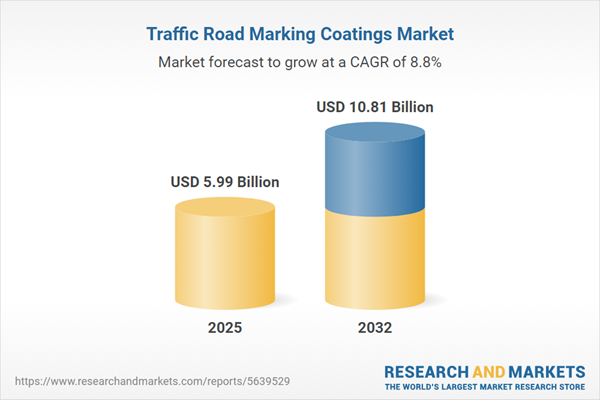Speak directly to the analyst to clarify any post sales queries you may have.
Senior executives driving transportation and infrastructure priorities must navigate complex regulatory, operational, and sustainability demands as the traffic road marking coatings market transforms to support safer, more efficient movement networks. In this evolving landscape, strategic choices in coatings technology and supplier partnerships are key to maintaining market advantage.
Market Snapshot: Traffic Road Marking Coatings Market
The global traffic road marking coatings market continues to expand, propelled by robust investment from both governmental and private sources aimed at upgrading roads and transportation corridors. Clear regulatory frameworks, along with a persistent focus on safety, are sustaining strong interest in new coating technologies. Collaboration among infrastructure owners and coating solution providers is fostering the development of performance-driven products. Companies that remain agile in adapting to ongoing compliance demands and who prioritize dependable solutions are increasingly able to differentiate themselves as procurement priorities evolve and stakeholders require enhanced operational performance.
Scope & Segmentation of the Traffic Road Marking Coatings Market
This comprehensive report is structured to equip senior leaders with actionable insights into the traffic road marking coatings market, focusing on meaningful segmentation and key factors shaping investment and technological direction. Understanding strategic differentiation in product applications, market regions, and user needs is critical for informed decision-making and growth planning.
- Product Types: Cold plastic coatings enable adaptive and durable road applications; epoxy-based coatings are optimal where strong adhesion is critical; solvent-based coatings provide efficiency for projects needing rapid turnaround; thermoplastic coatings offer reliable heat-applied solutions; water-based coatings are increasingly chosen for environmentally responsible and regulatory-compliant projects.
- Application Methods: Brush and roll systems are best for precise or confined markings; extrusion technologies deliver scalable solutions for larger surfaces; spray applications maximize efficiency and deliver consistency, even across diverse conditions.
- End Users: Municipal agencies need versatile products tailored to varied urban contexts; airport operators seek high-visibility, high-durability coatings; contractors require flexible solutions suitable for diverse projects; industrial stakeholders focus on compliance and site-specific performance needs.
- Marking Types: Coatings for car parks and crosswalks address organized movement and pedestrian safety; roadway markings emphasize clear guidance for vehicles; signage coatings play a role in the integration of traditional and digital transport management, particularly as smart city initiatives continue to advance.
- Regions: Market approaches must be adapted regionally, with the Americas, Europe, Middle East & Africa, and Asia-Pacific displaying diverse infrastructure priorities, compliance demands, and adoption rates for new technology. Regional dynamics shape procurement strategy, performance expectations, and environmental considerations.
- Key Companies: Notable participants include PPG Industries, The Sherwin-Williams Company, Akzo Nobel N.V., Kansai Paint Co., Nippon Paint Holdings, Axalta Coating Systems, Hempel A/S, SWARCO AG, Colas, and Asian Paints Limited, all leveraging broad material expertise and global partnerships to reinforce sector leadership.
Key Takeaways for Senior Decision-Makers
- Selecting advanced, long-life coatings allows organizations to minimize repair frequency and limit operational disruptions, contributing to reliable transport networks and improved asset performance.
- Aligning procurement with a shift toward water-based or bio-based coatings helps meet current and anticipated sustainability directives and bolsters organizational reputation in public infrastructure projects.
- The adoption of sensor-enabled coating technologies opens opportunities for real-time monitoring, facilitating more responsive asset management and resource allocation.
- Continuous progress in material science is boosting coating durability and allowing assets to withstand higher traffic volumes and diverse weather challenges effectively.
- Collaborating closely with regional suppliers and logistics partners increases operational agility, which is especially important in adapting to compliance changes and navigating evolving supply chain contexts.
Tariff Impact on Supply Chains and Cost Structures
- Changes in U.S. tariffs create raw material cost volatility, prompting a focus on supply diversification and stronger ties to domestic procurement networks.
- Organizations are applying adaptive logistics and robust inventory management to minimize project delays, ensuring continuity amid shifting tariff scenarios.
- Remaining responsive to tariff fluctuations and expanding the supplier base is essential for both profitability and ongoing access to necessary coating inputs.
Methodology & Data Sources
Analysis is based on a synthesis of structured interviews, regulatory and academic research, and field data, with validation by an expert industry panel to ensure applicability of findings for senior leadership decision-making.
Why This Report Matters
- Delivers actionable benchmarks and tailored insights for resource allocation, technology investment, and contingency planning to support resilience.
- Assists organizations in extending infrastructure lifespans, integrating digital advancements, and aligning sustainability practices with evolving standards.
- Provides region-specific guidance to help streamline compliance and procurement strategies across varied market environments.
Conclusion
Senior executives leveraging this analysis will be equipped to anticipate regulatory shifts, accelerate innovation, and optimize operations, positioning their organizations for sustained success in the evolving traffic road marking coatings market.
Additional Product Information:
- Purchase of this report includes 1 year online access with quarterly updates.
- This report can be updated on request. Please contact our Customer Experience team using the Ask a Question widget on our website.
Table of Contents
3. Executive Summary
4. Market Overview
7. Cumulative Impact of Artificial Intelligence 2025
Companies Mentioned
The companies profiled in this Traffic Road Marking Coatings market report include:- PPG Industries, Inc.
- The Sherwin-Williams Company
- Akzo Nobel N.V.
- Kansai Paint Co., Ltd.
- Nippon Paint Holdings Co., Ltd.
- Axalta Coating Systems Ltd.
- Hempel A/S
- SWARCO AG
- Colas
- Asian Paints Limited
Table Information
| Report Attribute | Details |
|---|---|
| No. of Pages | 188 |
| Published | October 2025 |
| Forecast Period | 2025 - 2032 |
| Estimated Market Value ( USD | $ 5.99 Billion |
| Forecasted Market Value ( USD | $ 10.81 Billion |
| Compound Annual Growth Rate | 8.8% |
| Regions Covered | Global |
| No. of Companies Mentioned | 11 |









